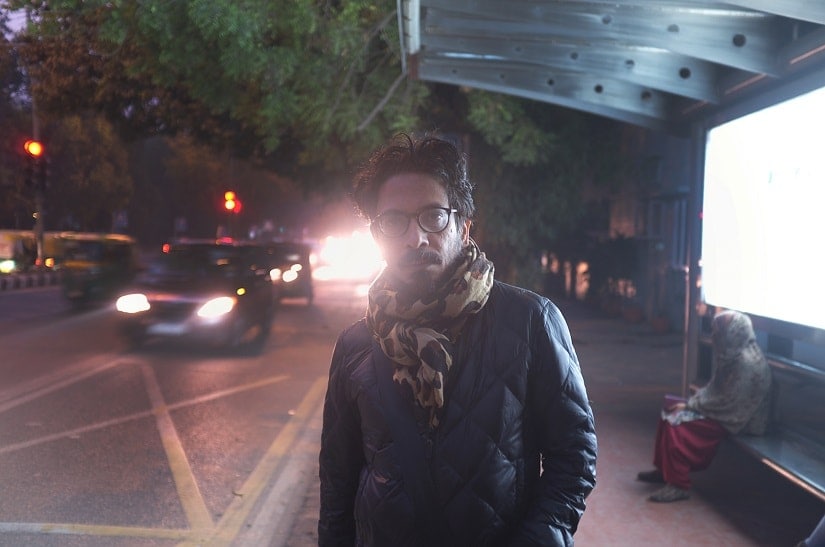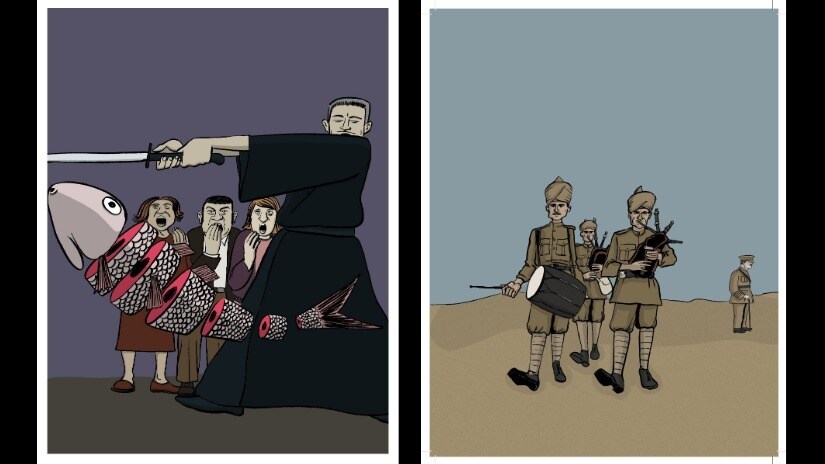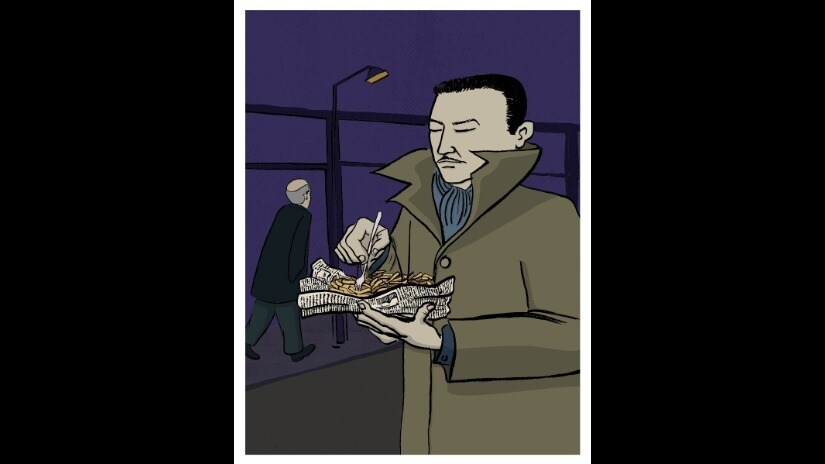Graphic novelist and artist Sarnath Banerjee, known for his path-breaking work of graphic fiction Corridor, is out with his latest book. Doab Dil (Penguin Randomhouse India) takes us into history — alternating fact and fiction to create a narrative that is compelling, informative and visually stunning. One chapter looks at historical figures – Søren Kierkegaard, Mahatma Gandhi and Werner Herzog – who loved walking. There’s an exploration of nighttime in cities, of insomnia, of the different postures that make up a person’s daily life (aptly called the ‘Daily Decathlon’). Another section is the ‘Doab Dil Desert Island Disc’, showcasing his visual interpretation of verses of popular songs.
It’s not just another graphic novel, but what the author calls ‘an illuminated text’.
Some stories are visual; others use text as a storytelling device. The book’s structure, Sarnath says, borrows from the Japanese form of ‘Renga’ or interlocking poetry, and is inspired by Indian visually-driven oral story-telling traditions. In February 2019, the Berlin resident was in India to launch his solo show at the Dr Bhau Daji Lad (BDL) Museum, titled Spectral Times. The show looks at an unexplored, supernatural side of Mumbai and is narrated in the form of magazine interviews with reporter Birjis Bari from The Spectral Times. “The episodes are driven by real anxieties of modern living. The fictitious interviews reflect on a post-truth, belief-oriented society,” says Banerjee. There are nods to Doab Dil too. In an interview with Firstpost, Banerjee spoke of today’s post-truth world, his love for history, and how bedtime stories with his son sparked the idea for his next book. Excerpts: [caption id=“attachment_6252171” align=“alignnone” width=“825”]  Sarnath Banerjee. Photo courtesy Hemant Sareen[/caption] Doab Dil moves between fiction and non-fiction. Is this another aspect of the ‘do ab’ of the title? Do you want people to sift out the truth from the fiction? In DD, I have often used facts to fire up imagination. In this age of truth-manufacturing industries, falsehood reigns in the form of fake news, propaganda and internet trolling. I am skeptical of people who offer ‘Truth’ with a capital T. If you push forward a point emphatically, persistently and loudly enough, you can create your private truth. In recent times, we have seen that being played out among hyper-nationalists. Fiction is one way to subvert this. In fiction, there is no tall claim for the truth-telling and truth often slips through. A lot of the mentions in Doab Dil are facts but because the reader is not sure, she is encouraged to look up. Therefore, while reading the book she alternates between two states — a willful surrender to a story and the instinct to interrogate what she might think is fact. My characters are historically informed but do not claim historical accuracy. They merely encourage the reader to look deeper and with skepticism. I try and put out as many interpretations of a historical character or object as possible giving you the details you make your own deductions. [caption id=“attachment_6252181” align=“alignnone” width=“825”]  From Sarnath Banerjee’s Doab Dil[/caption] You have sought inspiration from historical and literary sources, from people who loved walking to the Victorian aristocracy’s pride in their gardens. Tell us about this love for history. I like working with historians, I learn in the process. Historians view history as an ongoing conversation — they need not arrive at a resolution but just add details to an event. Humanities teach us to accommodate multiple points of views and emancipate ourselves from the need for a singularity. We can all amicably disagree with things. While researching my second book on 18th century Calcutta I had spent a lot of time looking and drawing historical artifacts. This is how my love for historical objects developed. [caption id=“attachment_6252201” align=“alignnone” width=“825”]  From Sarnath Banerjee’s Doab Dil[/caption] Your solo show — Spectral Times — looks at history in another sense, through stories of ghosts. Why this fascination with the supernatural? Ghosts are unfinished speeches. No matter how much the upper-class Indians try to tidy up their lives by using self-serving life-philosophy, the real thing often creeps up like a ghost. The rot in society can be perceived through the cracks. There is a growing hyper-religiosity in the middle-classes. Affluent people often talk of mini-temples or shrines in their houses. Spiritual gurus have become thought captains. I wonder if all this is a by-product of the rising unease of a society of huge discrepancies. Books on mythology have become hugely popular. Mythology photoshops your personal, regional or national identity in accordance with your desires. History is ruder. It doesn’t really obey. Neither do ghosts. [caption id=“attachment_6252211” align=“alignnone” width=“825”]  From Sarnath Banerjee’s Doab Dil[/caption] Your show uses text, illustration and radio. Why did you choose to go the multimedia way? I feel there is a general visual overload today. The movie industry is taking away our own imagination from ourselves. Nowadays when we are asked to imagine a middle-class household, we can only imagine a Bollywood or Netflix version of it, when our own imagination is perhaps richer. Radio encourages that and therefore it is perhaps a better visual medium. It collaborates with the listener and processes the images that are in her head. Imagination is vital. It is our therapy against an alien and sometimes hostile world. The more we lose it, more we make ourselves susceptible to received wisdom. We become templates and leave it to mainstream entertainment to imagine for us. Even when we have to protest against something, we do it without imagination, we just troll. [caption id=“attachment_6252221” align=“alignnone” width=“825”]  Installation view of Commonplace Utopia – 1/ Digital Print, 2016-17. Image courtesy Dr Bhau Daji Lad Museum, Mumbai[/caption] The graphic novel in India has grown in terms of complexity and diversity of topics with many focusing on topical, even political, issues. Are these topics you wish to approach in future works? I am not very good at handling topical events. I take a long time to arrive at a narrative. There is politics in my work, but I have a slight allergy with the word ‘political-artist’. My work is not activism-oriented either. To do that, you need a clear point of view and a strong belief system. I don’t have either. I do admire those who do activist-comics; luckily, we have some very powerful ones in India. [caption id=“attachment_6252231” align=“alignnone” width=“825”]  Installation view of Commonplace Utopia – 1/ Digital Print, 2016-17. Image courtesy Dr Bhau Daji Lad Museum, Mumbai[/caption] What are you currently working on? A children’s book on jinns, set in Karachi and Calcutta. These stories were originally told as bedtime tales to my son. Through these stories, we evoke two great South Asian cities on cold rainy nights in Berlin. The stories are re-imaginations of neighbourhoods of Karachi-buildings, kitchens, market places, characters and the numerous communities. They explore the class-system, Karachi’s colonial history, the Sindh Club, Lyari etc and juxtapose them with Calcutta. The cast of characters primarily includes several jinns who had overrun the city, an evil Chinese dentist who is the jinn-master, a slightly corpulent and incredibly lazy Inspector Ali (based on my son) and a harmonium-maker-cum-weapon expert in Calcutta and a supportive jinn called Sumojinn. This apart, I am working on a collaboration with psychiatrist Vikram Patel, putting together a pictorial survey of the mental health landscape. It’s a sort of a ‘vickypaedia’ of how a psychiatrist looks at contemporary Indian society. Spectral Times is on view at the BDLM in Mumbai till 26 May; between 10 am to 5.30 pm. Open to all with Museum entry ticket.


)
)
)
)
)
)
)
)
)



